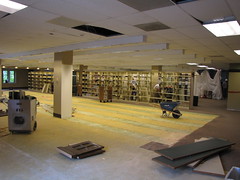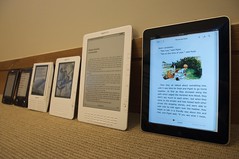
Speaker: David Weinberger
When you are thinking about ebooks as digital, you are reproducing the limitations of print books in that they are disconnected media. It’s not just the commercial enterprises that approach it that way, libraries do it too in the way we digitize our materials.
The revolution isn’t in digitizing, it’s in the networking of content.
Libraries as platform provide some unifying framework for thinking about ___.
Libraries as platform enable us to take social networks seriously.
Libraries as platform increases the perceived and real values of the library.
A platform is not a portal. They allow networks to arise, beyond the simple portal-based access to resources.
Internet-style knowledge networks are really, really big. There is no known limit, and they are highly interconnected (linked).
The traditional-style knowledge networks has been paper, books, and libraries. We have accepted the inherent limitations of this model, and the filters (selection) that come with it. For example, footnotes are stopping points and a hassle to follow-up on. Peer review doesn’t scale.
Knowledge now lives in the network, in the connections.
If you go on the ‘net for more than a few minutes, you will discover that we don’t agree about anything. It should be concerning to us that the knowledge we have now is based on disagreement. On the positive side, we are discovering ways to disagree fruitfully, such as the way that linked data allows scientists to talk about the platypus without dissolving into arguments about whether it is a fish or a mammal.
Software developers now live in the fastest, most effective and efficient ecosystem for learning ever.
The power of iteration is that we can’t comprehend scale, so with small changes we get to scale without having to think the whole process through first. This system only works with humility and generosity, and holding back is sometimes considered to be an act of aggression. Public learning is also an important component of this.
We think of the Internet as this incredibly diverse space, but in reality, we humans tend to group together with like individuals. This can result in an echo chamber environment, which can make us more confirmed and stronger in our beliefs. There are flaws in the echo chamber argument, but it is something we need to be aware of. For libraries, this means we should also steer people to the resources that argue with what we consider to be the most authoritative.
Reddit, for example, is an echo chamber. It is atheistic (assumes all rational people are atheistic). It loves Neil Degrasse Tyson. It loves cute animal pictures. It loves altruism. It has it’s own language and memes. These are tests of whether you are part of the community. However, there is a function of Reddit that allows for a respectful engagement of different perspectives (IAMA), and this can only happen because the community has figured out how to open some windows within the echo chamber.
The range of services libraries provide is HUGE. These are things that we can develop as networked platforms.
Successful social networks are successful because they allow people to connect through social objects. The best example of this is a puppy on a leash — walk around with one of those and you will form social networks.
Open innovation allows us to create tools and services for our users.
The data & metadata distinction doesn’t work very well anymore. For example, if you know the name of the author and can’t remember the book title, then the author name becomes the metadata used to find the book. Metadata is the thing that you know, data is the thing that you are looking for.
Define your back-end systems to support the needs of the users. If you don’t know what that will be, open it up. Share your work. And this means we need to rethink privacy (balance risk & benefit).
Some suggested edits for Ranganathan:
Books are for use.
Every reader his [or her] book.
Every book its reader.
Every book its network.
Improve Save the time of the reader.
The library is a growing organism.




